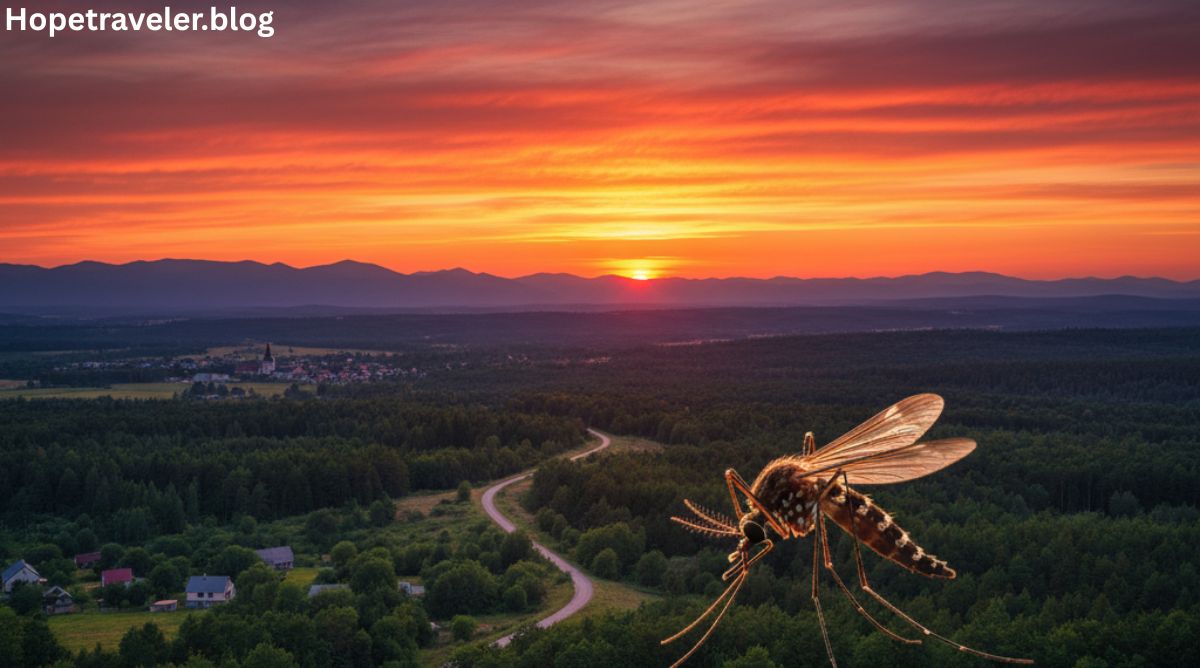Mosquitoes are small, buzzing insects that most people find annoying — and for good reason. They bite, cause itchy welts, and can even transmit dangerous diseases. But have you ever wondered how far do mosquitoes travel? Understanding the travel range of mosquitoes is essential not just for curiosity’s sake but also for public health, pest control, and disease prevention.
In this article, we’ll explore how far mosquitoes can travel, what factors affect their flight distance, and why knowing their range is crucial for controlling mosquito-borne illnesses.
What Are Mosquitoes?
Mosquitoes belong to the Culicidae family, a large group of insects with over 3,500 known species. These small, winged creatures are found in nearly every part of the world except Antarctica.
Only female mosquitoes bite humans and animals because they need blood to produce eggs. Males, on the other hand, feed primarily on nectar and plant juices.
👉 Learn more about mosquitoes on Wikipedia’s Mosquito page.
Understanding Mosquito Flight and Behavior
To understand how far mosquitoes travel, we first need to look at their flight behavior.
Mosquitoes are not strong fliers compared to other insects like bees or dragonflies. Their flight is often slow, and they tend to stay close to their breeding sites. Most mosquito species prefer short-range travel, typically within 100 to 400 meters (about 300 to 1,200 feet) from where they hatch.
However, several factors influence their travel range:
- Species type
- Environmental conditions
- Availability of food and breeding sites
- Wind patterns
- Human movement and transportation
How Far Do Most Mosquitoes Travel?
The distance a mosquito can travel depends largely on its species. Let’s break down some examples.
1. Aedes Mosquitoes
The Aedes genus includes species like Aedes aegypti and Aedes albopictus (Asian tiger mosquito). These mosquitoes are known carriers of diseases such as dengue fever, Zika virus, and chikungunya.
- Flight range: 50 to 200 meters (165 to 650 feet)
- Habitat: Urban areas, near standing water sources like flowerpots, tires, and gutters.
Aedes mosquitoes usually don’t travel far from where they hatch. They thrive close to human habitats because they rely on people for both food (blood) and breeding sites (water containers).
2. Culex Mosquitoes
Culex species are common in both urban and rural environments and can transmit West Nile virus and encephalitis.
- Flight range: Up to 2 kilometers (1.2 miles)
- Habitat: Stagnant water, sewers, and ditches.
Culex mosquitoes are medium-range travelers and can easily move between neighborhoods, making them harder to control.
3. Anopheles Mosquitoes
The Anopheles genus includes mosquitoes that carry the malaria parasite.
- Flight range: Up to 5 kilometers (3 miles)
- Habitat: Marshes, ponds, and natural wetlands.
Some Anopheles species can travel several miles in search of blood meals or breeding areas, especially in rural or open landscapes.
Record Travel Distances of Mosquitoes
While most mosquitoes stay close to their birthplace, there are exceptions.
- Saltmarsh mosquitoes (Aedes vigilax, Aedes sollicitans) are known for long-distance flights, sometimes traveling up to 30–50 kilometers (20–30 miles).
- These mosquitoes breed in coastal marshlands, and wind currents can carry them over vast distances inland.
This means a mosquito biting you in a suburban area could have originated from a salt marsh many miles away!
Factors That Influence Mosquito Travel Distance
1. Wind
Mosquitoes are lightweight and can be carried by wind currents far beyond their normal range. A moderate breeze can move them several kilometers away from their origin.
2. Availability of Water
Mosquitoes lay their eggs in standing water — ponds, puddles, containers, or even bottle caps. If water sources are abundant, mosquitoes tend to stay close. When water becomes scarce, they travel farther to find new breeding grounds.
3. Temperature and Humidity
Mosquitoes thrive in warm, humid environments. In hot climates, they may travel farther to find cooler, shaded areas, while in dry conditions, their movement decreases as they seek out moisture.
4. Food Sources
Female mosquitoes are attracted to carbon dioxide (CO₂) and body heat emitted by humans and animals. When hosts are scarce, they may travel further in search of a blood meal.
5. Human Transportation
Mosquitoes can “hitchhike” on vehicles, airplanes, or ships — traveling hundreds or even thousands of miles unintentionally. This is one of the ways invasive mosquito species like the Aedes albopictus have spread globally.
How Far Do Mosquitoes Travel in Their Lifetime?
The lifespan of a mosquito varies by species and environment but typically ranges from two weeks to one month.
During this short life, most mosquitoes do not move far from their birthplace.
- Average travel range: 1–2 kilometers (0.6–1.2 miles).
- Long-distance species: Up to 50 kilometers (30 miles) in total over their lifespan.
So, while mosquitoes may not seem like globe-trotters, they can still cover surprising distances when conditions are right.
Why Mosquito Travel Distance Matters
Understanding mosquito travel behavior is critical for public health and pest control.
1. Disease Prevention
Many mosquito-borne diseases depend on mosquito mobility. For example, malaria, Zika, dengue, and West Nile virus spread faster when mosquitoes can travel between communities.
Knowing their travel range helps health officials predict where outbreaks may occur and where to target control efforts.
2. Pest Control Strategies
If mosquitoes only travel 200 meters from their breeding site, pest control programs can focus within that radius. But if they travel miles, control efforts must be much wider and more coordinated.
3. Environmental Management
Understanding how far mosquitoes travel helps determine where to eliminate breeding sites, apply larvicides, and introduce natural predators like dragonflies or fish that eat mosquito larvae.
Can Mosquitoes Travel Across Countries?
In general, mosquitoes cannot fly across countries on their own — but humans help them do so.
Through international trade and travel, mosquitoes have spread from their native regions to new continents. For example:
- Aedes aegypti originated in Africa but spread globally through shipping routes.
- Aedes albopictus (Asian tiger mosquito) traveled from Asia to Europe and the Americas via shipments of used tires containing water and larvae.
This global spread has allowed mosquitoes to colonize new environments and increase the risk of disease outbreaks worldwide.
Interesting Facts About Mosquito Travel
- Speed: Mosquitoes fly at about 1–1.5 miles per hour (1.6–2.4 km/h).
- Height: They usually fly close to the ground (under 25 feet) but can reach up to 40 feet if wind supports them.
- Urban Mosquitoes: Tend to stay within a single city block or backyard.
- Rural Mosquitoes: Can travel several miles in search of water and food.
How to Protect Yourself from Traveling Mosquitoes
Whether mosquitoes come from your backyard or miles away, the best protection is prevention.
- Eliminate standing water around your home (buckets, flower pots, gutters).
- Use insect repellent containing DEET, picaridin, or oil of lemon eucalyptus.
- Install window screens to prevent entry.
- Wear long sleeves and pants outdoors, especially during dawn and dusk.
- Support local mosquito control programs to keep communities safe.
Conclusion
So, how far do mosquitoes travel?
While most species fly only 100 to 400 meters, some — like saltmarsh mosquitoes — can travel up to 50 kilometers (30 miles) under the right conditions. Factors like wind, environment, and human movement can extend their range even further.
Understanding mosquito travel behavior isn’t just a scientific curiosity — it’s vital for controlling diseases, managing the environment, and ensuring public health.
Next time you hear a mosquito buzzing, remember: it might have traveled a long way to find you!
Wikipedia Reference:




